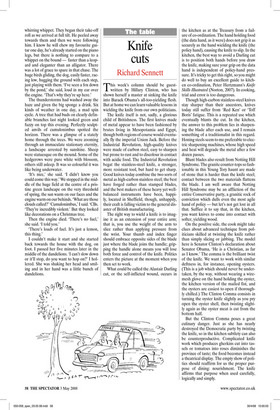Knife cuts
Richard Sennett
This week’s column should be guestwritten by Hillary Clinton, who has shown herself a master at sinking the knife into Barack Obama’s all-too-yielding flesh. But at home we can learn valuable lessons in wielding the knife from our own politicians.
The knife itself is not, sadly, a glorious child of Britishness. The first knives made of metal appear to have been fashioned by brutes living in Mesopotamia and Egypt, though both regions of course would eventually fly the imperial Union Jack. Before the Industrial Revolution, high-quality knives were made of carbon steel, easy to sharpen but prone to rust and to discolour in contact with acidic food. The Industrial Revolution begat the stainless-steel knife, a stronger, more resistant tool, but hard to get sharp. Good knives today combine the two sorts of metal as high-carbon stainless steel; the best have forged rather than stamped blades, and the best makers of these heavy yet wellbalanced instruments have been, happily, located in Sheffield, though, unhappily, their craft is falling victim to the general disaster of British manufacturing.
The right way to wield a knife is to imagine it as an extension of your entire arm; that is, you use the weight of the arm to slice rather than applying pressure from the wrist. Your thumb and index finger should embrace opposite sides of the blade just where the blade joins the handle; gripping the handle alone means you will lose both force and control of the knife. Politics enters the picture at the moment when you then set to work.
What could be called the Alastair Darling cut, or the self-inflicted wound, occurs in the kitchen as at the Treasury from a failure of co-ordination. The hand holding food (the data hand, as it were) does not grip it as securely as the hand wielding the knife (the policy hand), causing the knife to slip. In the kitchen, the best way to avoid a Darling cut is to position both hands before you draw the knife, making sure your grip on the data hand is independent of policy-hand pressure. It’s tricky to get this right, so you might do well to buy an excellent guide to kitchen co-ordination, Peter Hertzmann’s Knife Skills Illustrated (Norton, 2007). In cooking, trial and error is too dangerous.
Though high-carbon stainless-steel knives stay sharper than their ancestors, knives today still suffer from ‘Red Ken’ or ‘Toff Boris’ fatigue. This is a repeated use which eventually blunts the cut. In the kitchen, the answer to this problem lies in sharpening the blade after each use, and I remain something of a traditionalist in this regard. Honing steels seem to me preferable to electric sharpening machines, whose high speed and heat will degrade the metal after a few dozen passes.
Blunt blades also result from Notting Hill Syndrome. The granite counter-tops so fashionable in this Young Tory haunt are made of stone that is harder than the knife steel; contact between the two materials flattens the blade. I am well aware that Notting Hill Syndrome may be an affliction of the entire Conservative party, a granitic rock of conviction which dulls even the most agile hand of policy — but let’s not get lost in all that. Suffice it to say that, in the kitchen, you want knives to come into contact with softer, yielding wood.
On the positive side, the cook might take clues about advanced technique from politicians skilled at twisting the knife rather than simply slicing or jabbing. The model here is Senator Clinton’s declaration about Senator Obama, ‘He is a Christian, as far as I know.’ The comma is the brilliant twist of the knife. We want to work with similar deftness in, for instance, opening oysters. (This is a job which should never be undertaken, by the way, without wearing a wiremesh glove on the hand holding the oyster, the kitchen version of the mailed fist, and the oysters are easiest to open if thoroughly chilled.) The Clinton Comma consists in turning the oyster knife slightly as you pry open the oyster shell, then twisting slightly again as the oyster meat is cut from the bottom half.
But the Clinton Comma poses a great culinary danger. Just as she has nearly destroyed the Democratic party by twisting the knife, so in the kitchen subtlety can also be counterproductive. Complicated knife work which produces gherkins cut into tassels or tomatoes into roses diminishes the province of taste; the food becomes instead a theatrical display. The empty show of politics should reaffirm for us the proper purpose of dining: nourishment. The knife affirms that purpose when used carefully, logically and simply.


















































































 Previous page
Previous page